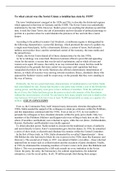To what extent was the Soviet Union a totalitarian state by 1939?
The term 'totalitarianism' emerged in the 1920s and '30s, to describe the dictatorial regimes
which appeared at that time in Germany and the USSR. The Soviet Union was undoubtedly
totalitarian by the late 1930s. However, Stalin's power was anything but absolute up until that
time. It took the Great Terror, the cult of personality and two decades of political patronage to
put him in a position where he could abandon the pretences of law and rule like a tsarist
despot.
According to the political scientist Carl Friedrich, a totalitarian regime is distinguished by
the following characteristics: a powerful ideology, which promised the onset of a golden era;
a single mass-based party, led by a charismatic dictator; a system of terror, built around a
ruthless secret police force; and the centralised control of the economy, the mass media and
the armed forces.
Clearly, the Soviet Union shared all of these characteristics by the late 1930s.
As far as ideology was concerned, Marxism-Leninism offered a powerful and appealing
vision for the nation: a society that was devoid of exploitation, and in which all men and
women were equal. Of course, the reality in no way mirrored that vision, but this could be
rationalised on the grounds that state control was necessary until capitalism had been
vanquished elsewhere in the world. Marxism also offered a deterministic interpretation of
history, in which all societies were moving towards socialism. Hence, dissidents (those who
opposed the Stalinist vision) could be swept away on the grounds that they were standing in
the way of history.
Politically, the Soviet system had many characteristics of totalitarianism even before Stalin
had consolidated his rule. Russia had become a one party state within a year of the Bolsheviks
seizing power, and that party soon grew to have millions of members. With the outbreak of
the civil war, the Cheka had been given the power to deal with enemies of the Revolution
without the inconvenience of a trial. No one knows how many people were put to death in this
way between 1918 and 1924, but it was at least 70,000 and possibly as many as a quarter of a
million. -USE IN CONCLUSION
Even so, the Communist Party itself retained many democratic elements throughout the
1920s. Stalin needed the support of his colleagues to attain pre-eminence within the Politburo,
and this dependence continued until the 1930s. Even as late as 1933, he was unable to
persuade his colleagues to have dissident elements within the party put to death. Only two
members of the Politburo (Molotov and Kaganovich) were willing to back him on this. Two
others (Voroshilov and Kalinin) were reluctant to agree, while the rest (Kirov, Ordzhonikidze,
Kossior, Kuibyshev and Rudzutak) were totally opposed.
To obtain absolute power, Stalin needed to circumvent the traditional avenues of authority
and resort directly to terror. Kirov's assassination gave him his chance. In 1936, he unleashed
a series of show trials, to discredit and eliminate his enemies within the Central Committee.
In the first of these trials, in 1936, Stalin eliminated the so-called ‘Oppositionists’ – those
Old Bolsheviks who had tried to block his rise to power in the 1920s (men like Kamenev and
Zinoviev). The second set of trials, in 1937, was aimed at Stalin’s own allies – those who had
opposed him on issues such as collectivisation and the execution of party dissidents. Finally,
in 1938, he eliminated the remaining members of Lenin’s inner circle (men like Bukharin and
Rykov). This was accompanied by a full-scale assault on every institution in the Soviet
Union: the party, the army, the bureaucracy, the cultural organisations, the industrial
enterprises, even the secret police. In all, 18 million people died during these purges.





